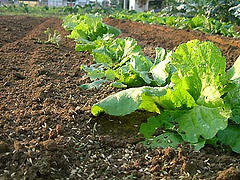Difference between revisions of "Chinese cabbage"
(→Controlled atmosphere considerations) |
|
| (2 intermediate revisions by the same user not shown) | |
(No difference)
| |
Latest revision as of 10:57, 23 March 2014
| Infobox on Chinese cabbage | |
|---|---|
| Example of Chinese cabbage |  |
| Freshness facts | |
| Optimum carrying temperature | 0°C |
| Highest freezing point | -0,9°C |
| Acceptable product temp. at loading into containers | Max. 2°C above carrying temperature |
| Optimum humidity | >95% |
| Ventilation setting for containers | 25 m³/hr |
| Storage life | 3 to 6 months |
| Climacteric / non-climacteric | Non-climacteric |
| Ethylene production | Very low |
| Ethylene sensitivity | High (russet spotting) |
| Modified / controlled atmosphere | 1%-2% O2; 2%-6% CO2 |
| Potential benefits | Good |
| Availability | |
| On demand | |
Chinese cabbage
Contents
Harvesting and Handling
Chinese cabbage can be divided into various head shapes, the two most common being the Nappa-type, which is short and broad, and the celery cabbage type, which is long and tapered.
Chinese cabbage should have uniform, tightly-formed heads with yellow-green, crinkly leaf blades. Head shape and leaf characteristics can vary, depending on the cultivar. There should be no evidence of leaf wilting or discolouration. Any damaged leaves should be removed, the heads packed into shipping containers and quickly cooled to reduce senescence.
Maturity is based on head compactness. A compact head can be only slightly compressed with moderate hand pressure. A very loose head is immature, and a very firm or hard head is mature.
Cooling and Storage
Chinese cabbage can be held in storage for 3 to 6 months, depending primarily on cultivar. The storage temperature should be as close as possible to 0°C without freezing. Decay and trimming loss is reduced by storage at a RH of 98% to 100%. Water loss during storage can be reduced and storage-life extended if heads are stored in perforated polyethylene bags. Storage-life is extended by growing Chinese cabbage during cooler growing seasons and placing the heads upside down during storage.
Chinese cabbage storability may depend, in part, on cultivar differences in chilling sensitivity. Chinese cabbage may develop a physiological disorder (brown midrib) after prolonged storage at 0°C. Freeze damage appears as darkened translucent or water-soaked areas that will deteriorate rapidly after thawing. Freeze damage can occur if round cabbages are stored below -0.9°C and if Chinese cabbage is stored below -0.6°C.
Controlled atmosphere considerations
Results are variable, but 1 to 2% O2 with CO2 of 2% to 6% is very effective at extending storage-life of Chinese cabbage. Specific CA recommendations depend on cultivar, temperature and storage duration. CA storage retains green colour, ascorbate and sugar content in leaves and decrease decay development. O2 atmospheres below 1% for will cause fermentation, and CO2 atmospheres >10% will cause internal discoloration.
Cabbages are sensitive to ethylene, which causes leaf abscission and leaf yellowing. Adequate ventilation during storage is important to maintain very low ethylene levels.
Storage disorders
Alternaria rot, Bacterial rots, Black rot, Cercosporella spot, Downy mildew, Grey mould rot, Leaf spot, Mosaic virus, Powdery mildew, Rhizoctonia rot.











